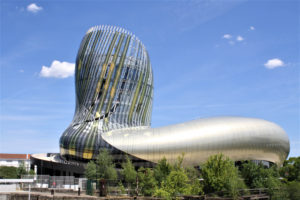| In 2017, La Cité du Vin in Bordeaux welcomed 445,000 visitors of 176 different nationalities, more than 1,000 French and international journalists, 1,100 groups and 400 private events. La Cité du Vin has seen a great success with its first two temporary exhibitions: Bistro! From Baudelaire to Picasso from 17 March to 21 June welcomed nearly 40,000 paying visitors, and the Invited Vineyard exhibition Georgia, cradle of viticulture welcomed more than 50,000 visitors from 31 July to 5 November.
——————-
Key attendance figures
· 445,000 visitors visited La Cité du Vin and the events in the cultural programme, to which can be added visitors to the free-access areas (La Boutique, the reading room, the gardens…) and the restaurants;
· 86% of the visitors were individuals, 14% visited in groups;
· More than 2,800 subscriptions have been sold: visitors convert their visit into a subscription so as to profit fully from the offer at La Cité du Vin.
Sales at the ticket counter
· 77% of visitors were French and 23% came from abroad.
· Among the French: 42% were residents, 40% French tourists and 18% were day trippers.
· Considering just the tourists, 43% of them were international and 57% French.
French visitors
· Bordeaux Métropole residents represent 42% of the French visitors and 87% of the visitors from the Gironde.
· Day trippers represent 16% of total sales, of which 42% Gironde, 11% Haute-Garonne and 13% Pyrénées-Atlantiques.
Breakdown by region
· The Nouvelle-Aquitaine region represents more than half of French sales (57%)
· Ile de France accounts for 1 French visitor in 10 on average (11%) and Occitanie 5%.
· Three regions stand out for their strong growth: PACA (+26%), Brittany (+38%) and Normandy (+60%).
Breakdown by conurbation
· Paris stands out (3% of visitors) followed by Toulouse (1% of visitors).
· Nantes, the south Arcachon basin and Lyon come next, with nearly 2,000 visitors (0.5% of the total).
· Levallois Perret is the headquarters for many works committees, which explains the high number of tickets, but the exact provenance cannot be identified.
In the Gironde
· The visitors live in a catchment area concentrated on a diagonal from Libourne to the south Arcachon basin.
Internationally
· 176 nationalities are represented: outside France, the English are in a majority, followed by the Americans and then the Spanish.
· 5 foreign countries account for 50% of sales: United Kingdom, United States, Spain, Switzerland and Italy.
· Top 7 European countries: United Kingdom, Belgium, Switzerland, Germany, Spain, Italy and the Netherlands.
· Top 7 countries outside Europe: United States, Canada, Australia, China, Brazil, Japan and Mexico.
Visitor satisfaction
A survey undertaken by Kedge Business School last August, in the scope of regular measures of visitor satisfaction, revealed that 96.5% of visitors were satisfied or delighted by their visit.
Opinion makers
More than 1,000 journalists and bloggers, French and international, were received at La Cité du Vin, generating more than 1,300 press mentions.
Temporary exhibitions
La Cité du Vin has seen a great success with its first two temporary exhibitions: Bistro! From Baudelaire to Picasso was held from 17 March to 21 June and welcomed nearly 40,000 paying visitors.
From 31 July to 5 November, the Invited Vineyard exhibition Georgia, cradle of viticulture welcomed more than 50,000 visitors. These exhibitions generated more than 300 articles in the press.
Private hire, an offer intended for companies and institutions
La Cité du Vin offers private hire of various areas for the organisation of corporate or institutional events. The Thomas Jefferson auditorium (250 seats) equipped with a control room and translation booths, and the belvedere (with a capacity of 200 people) situated at a height of 35 metres and offering an exceptional view of the city and the Garonne, are the core of the offer for private events. Added to these areas are the modular reception rooms with a total capacity of 250 people, as well as several meeting rooms with capacities from 12 to 70 people. In 2017, La Cité du Vin hosted 400 private corporate events, offering more than 27,000 professionals some unique experiences: private hire of the belvedere, the permanent tour, tasting workshops and private tours of the temporary exhibition.
Support the cultural seasons at La Cité du Vin with the Fondation pour la culture et les civilisations du vin: http://fondation.laciteduvin.com/en
About La Cité du Vin:
La Cité du Vin is a unique cultural facility located in Bordeaux, dedicated to wine as a cultural, universal and living heritage. It offers a spectacular journey around the world, through the ages and in all cultures. Visitors can purchase tickets at www.laciteduvin.com and at La Cité du Vin.
Ongoing events at La Cité du Vin:
· Visit of the Permanent Tour with the interactive travel companion and a world wine tasting in the Belvedere.
· Temporary exhibition: following the success of the major temporary exhibition Bistro! From Baudelaire to Picasso in 2017, La Cité du Vin will be presenting Wine and Music, harmony and dissonance from 23 March to 24 June 2018. The exhibition will include 150 works from regional, national and European collections, as well as a selection of musical works illustrating the association between wine and music, based on themes ranging from the mythical to the profane, epicurean to moralistic.
· A rich and varied cultural programme, with a steady stream of high-quality performances, concerts, screenings and debates. |











